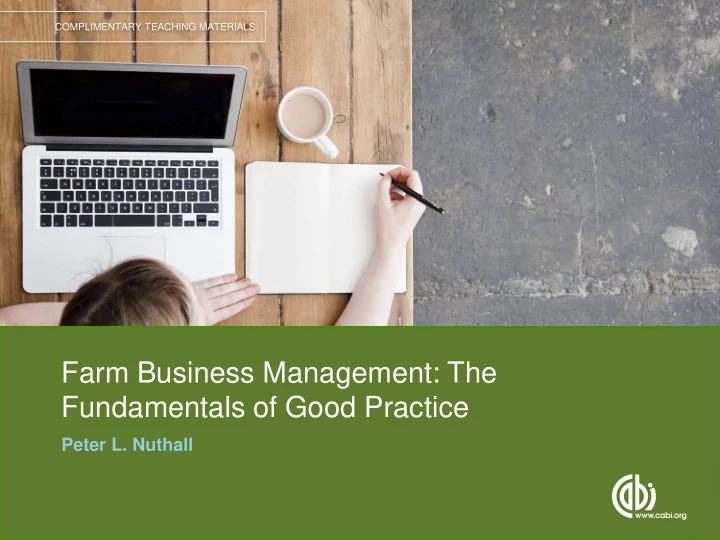

COMPLIMENTARY TEACHING MATERIALS Farm Business Management: The Fundamentals of Good Practice Peter L. Nuthall
Chapter 6 Introduction to Managing Risk and Uncertainty COMPLIMENTARY TEACHING MATERIALS
LEARNING OBJECTIVES Be reminded of the nature of non-certainty in farm planning and the impacts it has on a farm, farmer and farm family. Learn why it is important to account for non-certainty when planning. Discover how to measure non-certainty to enable formal decision analysis. Understand the management options and techniques a farmer can use to mitigate the effects of non-certainty. Find out how to put return figures on risky alternatives. Understand the concept of ‘subjective probabilities’. COMPLIMENTARY TEACHING MATERIALS
The Nature of Risk and Uncertainty Many inputs and most outputs from a farm plan are uncertain. To be successful, a manager must make allowances for this risk and uncertainty: • Will the bills be payable in poor years? • Will the plan be feasible in all years? • Will the owner be happy with the level of variability experienced? Risk and uncertainty is in part controllable: e.g. using diversification is one possibility. Reducing variability of net outcomes usually results in a lower average profit and other results. COMPLIMENTARY TEACHING MATERIALS
Measuring Risk and Uncertainty Outcomes, and some input requirements, can take on a range of values. Each has a specific chance of occurring (which itself can be uncertain): • degree of chance is measured by a number between 0 and 1 called a probability. 0 measures impossibility. • • 1 measures certainty. • >0 and <1 gives the likelihood of each possible outcome between the maximum and minimum possible. Sum of all probabilities must equal ‘1’. Expected outcome is the sum of multiplying the outcome values by their probabilities (some would call this an average or mean, but it is in the future and thus ‘expected’). COMPLIMENTARY TEACHING MATERIALS
Estimating Probabilities Can use historic data, e.g. rainfall records, yield records, input requirement records (hay requirements). Use records to estimate relative frequencies of ranges, and thus probabilities. In theory, each variable (output, or input requirement) follows a continuous distribution. History seldom repeats itself (the world is always changing), so modify probability estimates to suit future expectations. COMPLIMENTARY TEACHING MATERIALS
Sources of Risk and Uncertainty Note: non-certainty can be used to describe ‘risk and uncertainty’. • Yield and technical non-certainty. • Natural hazards (e.g. fire, flood). Price and cost non-certainty. • • Human non-certainty (e.g. will the helper ring in sick?). • Institutional non-certainty (e.g. will the local government change stream water withdrawal limits?). • Technical non-certainty (e.g. will the fungicide spray control the pest incursion?). • Financial non-certainty (e.g. will the banks increase the overdraft interest?). COMPLIMENTARY TEACHING MATERIALS
Attitudes to Risk and Uncertainty Everyone makes a different conclusion over the level of risk and uncertainty to accept. Differences are largely due to the farmer’s personality and upbringing. A plan should be designed to suit each individual’s attitude to risk and uncertainty. Extremes: the risk preferrer, who prefers a farm system that is quite variable and the risk averter, who prefers a farm system that is relatively consistent. The full range of farmer attitudes exists between the extremes. Trade-off: Note that reducing the level of variability in a plan usually means the average profit is reduced. COMPLIMENTARY TEACHING MATERIALS
Calculating Impact of Non-certainty Budget out sets of possible outcomes and weight each with its probability. Develop decision trees with branches to reflect decisions planned and the range of possible outcomes. Branches are for each act (decision) and outcome, and lead to the ‘leaf’ which represents each combination of decisions and chance events (seek out examples). Decision trees lead to pay-off matrices, a table giving combinations of decisions and outcomes. Use pay-off matrices to see profit distributions, expected values and extremes. COMPLIMENTARY TEACHING MATERIALS
Methods of Reducing Risk and Uncertainty • Insurance: regular certain cost to overcome uncertain cost or return. Diversification: produce extra products, or use different production • processes in the hope that when one is bad another will be good. • Contracts: fixes in price and/or quantities. • Products or production processes with inherently low variability (e.g. irrigation). • Asset structure (e.g. hold resources that can be realized when a need arises). • Flexible products (e.g. produce lambs that can be sold at different times). Flexible buildings and machinery (e.g. build a barn that can easily be • used for a range of purposes). Knowledge and information (e.g. study worldwide markets to better • predict prices). • Tax system: use schemes designed to even out taxable profit. COMPLIMENTARY TEACHING MATERIALS
Analysis Principles Use subjective probabilities to ensure result is appropriate to the decision maker (farmer). Subjective probabilities are where the decision maker uses her/his estimates and may be guided by objective probabilities (record based). Budget out possible combinations of decisions and outcomes. Impossible to do all because they are infinite in number, so select a range of representative values. In comparing alternatives, allow for risk attitude and minimum income and other requirements. Calculations can be extensive: more sophisticated analyses and techniques are possible with computer help. COMPLIMENTARY TEACHING MATERIALS
Thank You Name: First Surname Email: email@email.com COMPLIMENTARY TEACHING MATERIALS
Recommend
More recommend